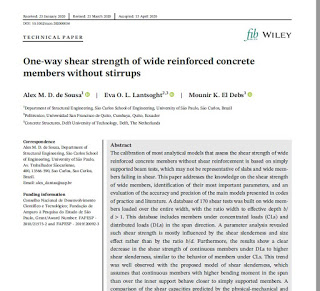One-way shear strength of wide reinforced concrete members without stirrups
Recently, I collaborated with colleagues in Brazil within the scope of the PhD research of the first author of this paper, published in Structural Concrete. You can access the paper here.
The abstract of the article is as follows:
The calibration of most analytical models that assess the shear strength of wide reinforced concrete members without shear reinforcement is based on simply
supported beam tests, which may not be representative of slabs and wide members failing in shear. This paper addresses the knowledge on the shear strength
of wide members, identification of their most important parameters, and an evaluation of the accuracy and precision of the main models presented in codes
of practice and literature. A database of 170 shear tests was built on wide members loaded over the entire width, with the ratio width to effective depth b/
d > 1. This database includes members under concentrated loads (CLs) and distributed loads (DLs) in the span direction. A parameter analysis revealed
such shear strength is mostly influenced by the shear slenderness and size effect rather than by the ratio b/d. Furthermore, the results show a clear
decrease in the shear strength of continuous members under DLs to higher shear slenderness, similar to the behavior of members under CLs. This trend
was well observed with the proposed model of shear slenderness, which assumes that continuous members with higher bending moment in the span
than over the inner support behave closer to simply supported members. A comparison of the shear capacities predicted by the physical-mechanical and
semiempirical approaches showed the higher accuracy and precision of models based on the critical shear crack theory and critical shear displacement theory,
regardless of the ratio b/d. Therefore, the same models derived based on beam tests are valid for wide members. Apart from that, the analyses of nonslender
members with some strain-based models combined with reducing factors of the acting shear load provide accurate results of shear strength for members
without stirrups.

